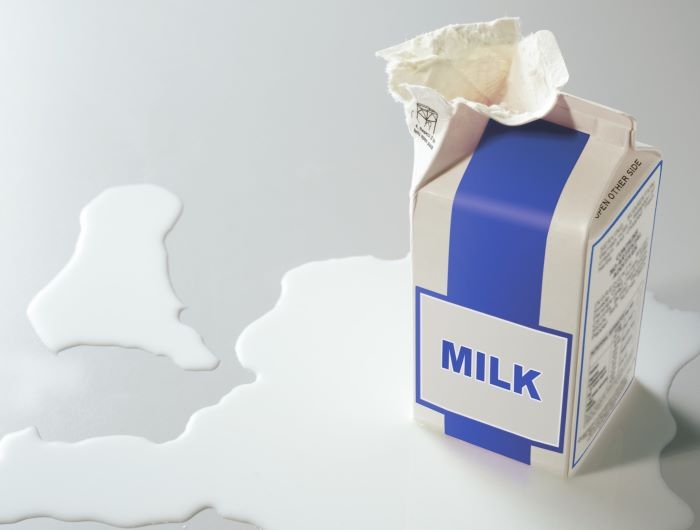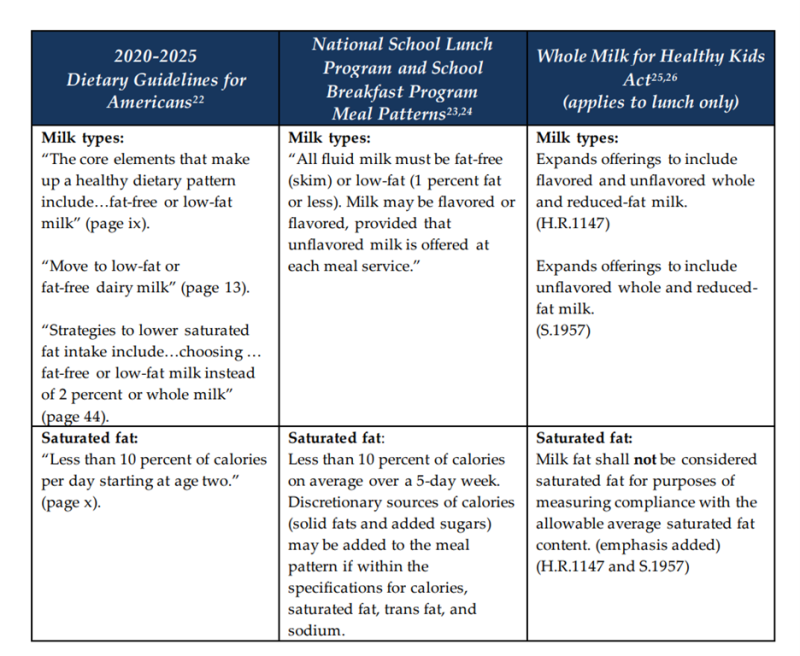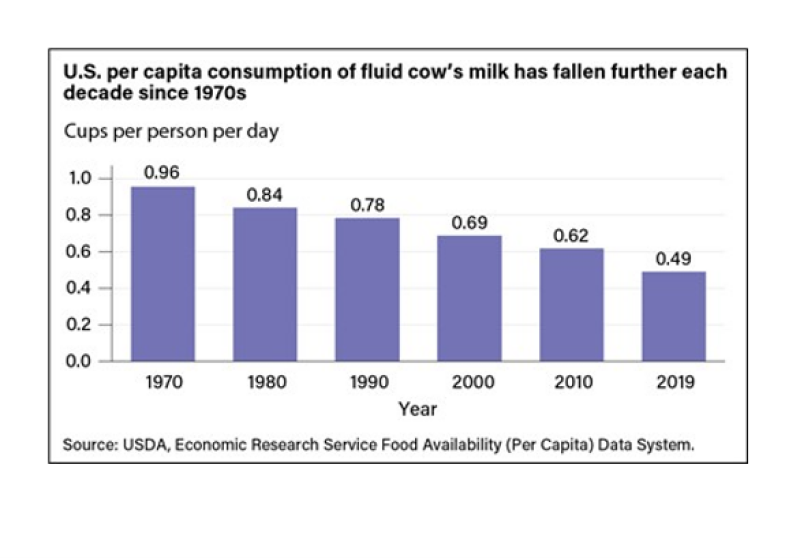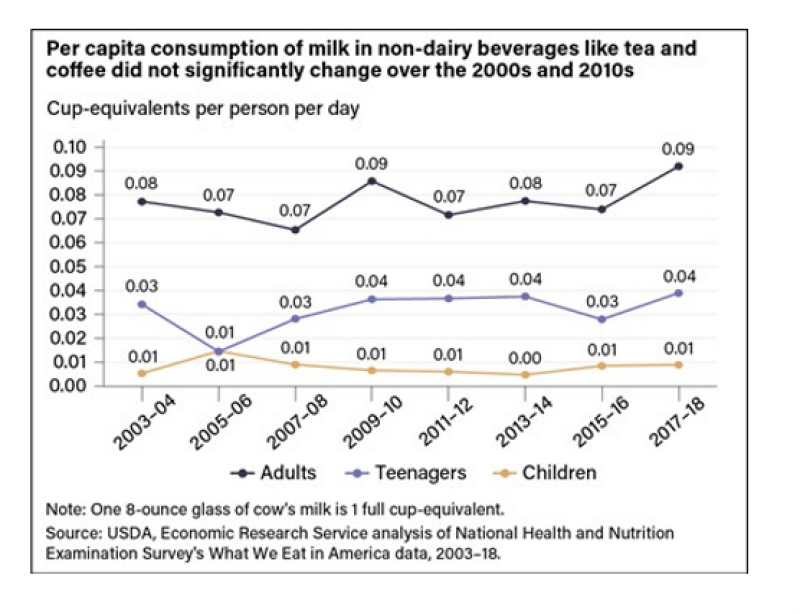Why milk served in schools is always low-fat or nonfat

Adrian Brockwell
Whole milk and 2 percent milk have been removed from school meals since 2012—but why? Here's everything you need to know about the research and the law, and why adhering to the Dietary Guidelines for Americans is crucial to student health.
As the misleadingly titled Whole Milk for Healthy Kids Act makes its way through the legislative process, it's important to understand why school meals come with only fat-free (skim) or low-fat (1 percent) milk, and how changing that could risk the health of the 30 million children who rely on school meals.
School meals and milk: How the guidelines are set
School meals served under the National School Lunch Program (NSLP) and School Breakfast Program (SBP) must meet nutrition standards, which include specified offerings of fruits, vegetables, and whole grains; staying within age-appropriate calorie ranges; reducing sodium; eliminating trans fat and limiting saturated fat. These standards are established by the U.S. Department of Agriculture (USDA) and are required by law to meet the federal Dietary Guidelines for Americans (DGAs). The DGAs are reviewed and revised every five years and are based on an extensive review of scientific evidence.
When was whole milk banned in schools?
Since 2012, whole and reduced-fat (2 percent) milk have not been permitted in school meals, which is consistent with the DGA recommendation to choose or switch to fat-free or low-fat milk to limit saturated fat consumption.
Why schoolkids are offered only low-fat and nonfat milk
Whole and reduced-fat milk are higher in saturated fat than fat-free and low-fat milk. Saturated fat is well-established to contribute to elevated LDL (“bad”) cholesterol, which is associated with an increased risk of heart disease. The 2020 Dietary Guidelines Advisory Committee found strong evidence that diets lower in saturated fat and cholesterol during childhood result in lower levels of LDL cholesterol throughout childhood.
To rein in other food sources high in saturated fat, school meals also have to meet an overall saturated fat limit: less than 10 percent of average daily calories in school meals over the course of the week may come from saturated fat, which is consistent with the DGA recommendation that less than 10 percent of calories should come from saturated fat per day starting at age two.
In addition to the DGA recommendations, other expert groups recommend lowering the consumption of saturated fat. The American Heart Association, American College of Cardiology, and National Heart, Lung, and Blood Institute recommend a dietary pattern that limits saturated fat and includes low-fat dairy products. Furthermore, the National Heart, Lung, and Blood Institute, the American Heart Association, the American Academy of Pediatrics, and the Academy of Nutrition and Dietetics all recommend that children aged 2 or older drink low-fat or fat-free milk.
Is there really that much saturated fat in whole milk?
According to USDA data, one cup of whole milk (the serving size of a school milk carton) contains around 4.5 grams of saturated fat, or approximately 18-34 percent of the maximum saturated fat recommended for school-aged children in a day (depending on sex, age, and activity level). It is so high in saturated fat that the government prohibits its labels from touting the health benefits of its other nutrients; fat-free and low-fat milk, however, can make these claims.
Even with the current nutrition standards that limit saturated fat in school meals, most children, on average, still consume more saturated fat than is recommended. According to the 2020-2025 DGA, more than 80 percent of 5-to-8 year-olds, 85 percent of 9-to-13-year-olds, and 75 percent of 14-to-18-year-olds consume too much saturated fat.
Bill would offer whole milk at school again
Lawmakers have introduced legislation that would override, or in the case of state legislation, circumvent, federal school meals standards, and permit whole and reduced-fat milk in school meals. The following table outlines the key pieces of the Dietary Guidelines, current NSLP meal pattern, and federal legislation under consideration.

Debunking claims about whole milk and healthy kids
Lots of claims have been made in support of offering whole milk in schools, but few—if any—hold water under scrutiny. The most frequent pro-whole-milk claims are presented below, and evidence-based responses are provided for each.
Claim: Kids hate the taste of fat-free milk
Fact: No, they don’t.
In fact, when it comes to taste, it appears that flavors like chocolate matter more than fat content. In a blind taste test funded and conducted by the dairy industry, 425 children aged 8 to 16 rated the taste of lactose-free milks on a scale of 0 to 100 for liking, where 0= hate and 100= love. One percent fat chocolate milk ranked highest (81 points), unflavored one percent (62) and unflavored two percent fat milk (61) were rated virtually identically, and unflavored fat-free milk was rated slightly lower (57 percent). (Whole milk, which is 3.25 percent fat, was not tested.)
Research funded by the American Dairy Association Northeast and the National Dairy Council found that, while students preferred skim milk the least, there was no significant difference in preference between unflavored one percent, two percent, and whole unflavored milk, when milk was served in clear cups. No differences were observed in flavor, mouthfeel, or liking for unflavored milk when milk was served in an opaque cup. For chocolate milk, at least one percent milkfat was preferred by students.
Claim: Restricting whole milk means more milk is wasted
Fact: Food waste is a serious problem, but removing whole and 2 percent milk from school meals didn’t change milk consumption—or food waste—at all.
Milk waste (and all food waste) in school cafeterias is a problem that must be addressed, but evidence does not support that waste is due to the fat content of milk. An analysis funded in part by the Dairy Research Institute of milk shipments to school before, during, and after a change to lower-calorie flavored milk found no change in average daily shipment of flavored or unflavored milk.
Claim: School nutrition standards have ruined a generation of milk-drinkers
Fact: Milk consumption has been on the decline for decades—certainly since long before the 2012 revisions to school nutrition standards.
According to a 2013 Economic Research Service (ERS) report, younger generations consume less milk than preceding generations, but this trend is not exclusive to schoolchildren starting in the 2010s. According to the ERS economists, “individuals born in the 1970s, for example, drank less milk in their teens, 20s, and 30s than individuals born in the 1960s did at the same age points. Those born in the 1980s and 1990s, in turn, appear likely to consume even less fluid milk in their adulthood than those born in the 1970s.”


Lactose intolerance should also be considered. According to the National Institute of Diabetes and Digestive and Kidney Diseases, the national average of lactose malabsorption (the inability to fully digest lactose) is approximately 36 percent, but African Americans, American Indians, Asian Americans, and Hispanics/Latinos are more likely to experience lactose malabsorption.
Claim: Kids will drink more soda if they can’t have whole milk
Fact: There is no evidence to support the claim that children turn to soda when they’re not provided whole milk.
Full-calorie soda is not permitted to be sold in schools, so there is no option to “substitute” fat-free or low-fat milk with full-calorie soda. Diet soda is permitted to be sold in high schools but cannot be provided as part of a reimbursable meal.
The bottom line on whole milk in schools
Claims supporting whole milk in schools are not supported by the Dietary Guidelines, which are based on an extensive review of the scientific evidence. School meals must be aligned with the recommendations of the DGA. Lawmakers should honor the independent and science-based process of updating the school meal nutrition standards consistent with the DGA and not put corporate interests over children’s health.
Tell your senators:
listen to the facts and choose kids' health over Big Dairy's interests
More resources
The Healthy, Hunger-Free Kids Act (HHFKA) of 2010 set higher nutrition standards for milk, whole grains, and sodium at school meals. However, over the past 12 years, these standards have been repeatedly undermined. CSPI's Milk, Whole Grains, and Sodium Nutrition Standards in School Meals fact sheet tracks this history from pre-HHFKA (2010) through 2022.
For more information about the relationship between dairy fat, saturated fat, and disease risk, see CSPI's comment to the 2020 Dietary Guidelines Advisory Committee (DGAC) about Dietary Fats and Cardiovascular Disease.

Tell Congress
Keep Big Dairy's Interests out of School Nutrition Standards
The Whole Milk for Healthy Kids Act (S. 1957) puts Big Dairy's interests before the health of students. Health authorities across the board recommend against whole milk for kids due to the higher saturated fat levels and increased risk of heart disease later in life. Tell your senator to listen to the facts and choose kids' health over industry pressure.

Stirring the Pot
Join the fight for safer, healthier food
Sign up to receive action alerts and opportunities to support our work in Stirring the Pot, our monthly newsletter roundup.

